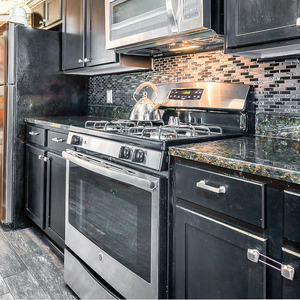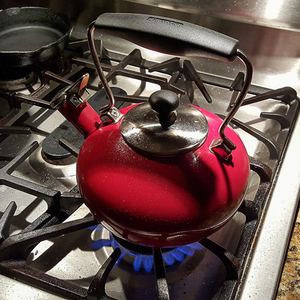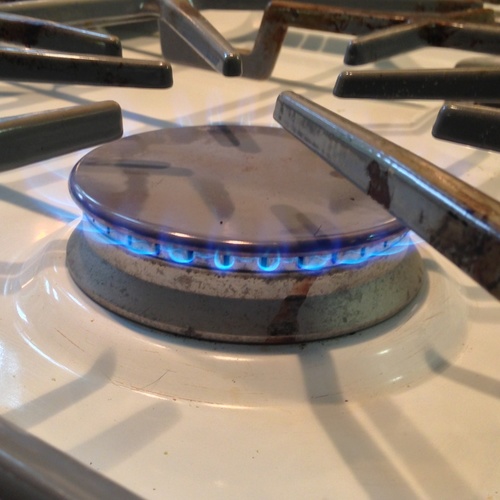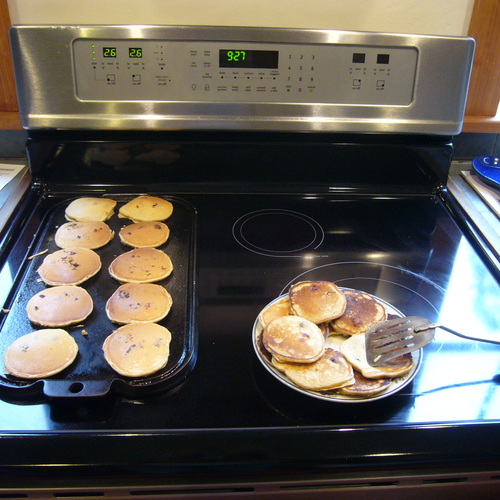
The reputation of gas stoves is in freefall—and if you’ve been paying attention to the news, you know that the blows have been unrelenting. For over a decade, GBA has been reporting on problems associated with kitchen ranges fueled by natural gas or propane.
It’s part of a system
The gas industry promotes the idea that gas stoves are safe because they are part of a system that includes a range hood fan designed to pull combustion byproducts out of the kitchen and send the gases outdoors. Unfortunately, most gas stove installations don’t include an effective exhaust system, so the scenario of a safe gas stove installation is mostly a fantasy.
Here are eight reasons why homeowners might want to get rid of gas stoves:
- Many gas stoves are installed in kitchens that lack exhaust ventilation.
- Even when a range hood fan is exhausted outdoors, operating the fan may depressurize the house, causing other combustion appliances to backdraft.
- Even when a range hood fan is exhausted outdoors, the range hood may have poor capture efficiency.
- Most homeowners don’t turn on their range hood fan.
- Gas stoves contribute to poor indoor air quality.
- Residents of homes equipped with a gas stove have a higher risk of asthma than residents of homes equipped with an electric stove.
- Most gas stoves continuously leak methane into the indoor air.
- The “electrify everything” movement provides a strong argument in favor of eliminating residential gas appliances.
Many homes have range hoods that aren’t vented outdoors
It’s fairly obvious that breathing gas fumes is a bad idea—although until recently, most homeowners didn’t know how bad. But gas stoves have range hood fans to take care of that problem—right?
Actually, there are several problems with existing range hoods.…
Weekly Newsletter
Get building science and energy efficiency advice, plus special offers, in your inbox.

This article is only available to GBA Prime Members
Sign up for a free trial and get instant access to this article as well as GBA’s complete library of premium articles and construction details.
Start Free TrialAlready a member? Log in















39 Comments
There really isn't any legitimate counter-argument.
only the obvious one, the grid cannot cope with this obvious swing in "electrify everything" movement, and the quotes are coming from "The Media" the most distrusted world organization, if the past 3 years are anything to go by. Plus, follow the money, see who gets the profit from this, not you or I that is for sure. Just another money making scam.
Tony,
Yes, I'm a journalist. That makes me a member of the media. As far as I know, I'm not part of a world organization... and no one has offered me a big cut of the profits that you seem to be talking about.
tonyj2768,
My post referred to legitimate arguments.
The grid is constantly being improved and it's not like electrify everything is going to happen overnight. Totally unfounded argument
I would consider replacing our 60" Viking range, but two big problems.. There are no induction stoves that size, and if there were, price would be astronomical. At least our range is in an open space containing living and dining that totals more than 800 square feet.
It sounds like two 30" cooktops would fit nicely. Do you use all 60"?
What is "astronomical" pricing to you? A 60" Viking is currently $20K to $25K.
I found "enjoy an annual gas bill of zero dollars" to be an "interesting" argument; perhaps you should consider adding "while enjoying an increased electricity bill" to present the whole picture? FWIW, I *am* building an all-electric super-insulated house, and even taking into account the sizable federal tax credit and extremely high electric rates in New Hampshire I really don't see how I could ever make a case that my $70k solar array will pay for itself in my lifetime. I happen to be able to afford this investment in my grandkids' future, but that's not true for a large number of folks out there.
Jandiedzic,
Many natural gas customers pay a fixed monthly fee even during months when they don't use any natural gas. Similarly, many propane customers pay a fixed fee to their propane supplier for tank rental.
If you've eliminated your gas furnace, gas water heater, and gas clothes dryer, there is a strong incentive to getting rid of your gas range: by getting rid of the last gas appliance in your house, you can eliminate the fixed fees associated with gas service. So I maintain that the result -- "an annual gas bill of zero dollars" -- is a result that feels good to most homeowners.
Marc Rosenbaum did the calculations comparing the amount of energy consumed by a gas range to the amount of energy consumed by an induction range, and he found that induction cooking uses significantly less energy than gas.
Concerning the other issue you raise -- the likely payback period for an investment in a $70,000 photovoltaic system -- that issue is irrelevant to my current article. My only comment: that sounds like an awfully big solar array.
I live near Stephen in Maine, and about a year ago I had a 6.4kW system priced out. Orientation is ideal and the system would produce about 7,200 kWh/yr, at an installed cost of about $22K, or $16K after tax credits. The installation company provides a lot of different metrics; one shows a 25 year equivalent rate of $0.08/kWh, or at 30 years it's $0.07/kWh. Compare that to grid-tied rates of about $0.21 last year and an estimated $0.43 in 25 years. Paying in cash, the system would break even in 9 years, or with a low-interest loan, in about 12 years.
Electrical rates in New Hampshire are similar. The only way I can see that a PV system wouldn't pencil out for you is if it's grossly oversized.
Curious what size home are you powering and is it an airtight home? I ask because we are in the process of planning a build and getting an idea of what a PV array might cost for us.
Martin - I would love to see Marc's calculations. He's a pretty sharp cat. The link doesn't work.
https://www.greenbuildingadvisor.com/article/an-induction-cooktop-for-our-kitchen
👍👍👍
Armando,
Thanks for alerting me to the bad link. (I've fixed it.) And thanks, Michael, for supplying the link for Armando.
Here's what I wrote on this topic in my article on induction cooktops:
"A few years ago, Marc Rosenbaum, an engineer in Massachusetts, measured the energy use of two different cooking appliances. Here’s what he wrote: 'I have a pretty good idea of how much energy we used in the gas range, because for several months our only gas appliance was the range. From a delivery on September 27, 2010 until we installed the new electric range in early April 2011, we used about 13 gallons of propane, or 2.1 gallon per month. That’s a gross input of about 192,000 BTU per month. I have a kWh meter on the electric [induction] range, and in four months it’s consumed 51 kWh, which works out to 174,000 BTU in total, or about 44,000 BTU per month. That’s 23% of the gas range consumption. If primary energy is accounted for, the new range is using about 60% of the primary energy that the gas range did.'
"If you assume that propane costs $3.89 per gallon, electricity costs 16 cents per kWh, and natural gas costs $17.49 per 1000 cubic feet (these are rough costs for Vermont), then Marc Rosenbaum’s cooking fuel costs would have been $8.17 per month using propane, or $3.36 per month using natural gas, or $2.04 per month using a induction range. Compared to propane, an induction range saves $6.13 per month."
Thanks, Martin. This is a great article. I'll use it to continue to educate my clients.
My solar array installed in 2015 cost us about $15,000 after federal tax credit. It produces about 8000 kwh per year. At current electric rate of just over 27¢ per kwh, it looks like a pretty quick payback.
A $70 K (before credits?) solar array must be around 25 kw. Should produce at least 20,000 kwh/year. What are you using all that power for?
And, unless you're operating a restaurant, cooktops of any type don't use much energy, compared with water heating or space heating .
> A $70 K (before credits?) solar array must be around 25 kw. Should produce at least 20,000 kwh/year.
They said after tax credits. But maybe $20k or so is for a battery, which would make sense for such a huge system.
Assuming good southern exposure, a 25kW should actually produce 32000 kWh/yr in New Hampshire, according to the Sunwatts calculator. Unless the house is absolutely gigantic, or they are massively over provisioning to be off grid (neither of which are the norm), something is off.
You're right about total production. Annual production is around 1.2 times installed capacity. If I was better at math, I'd have become an architect or builder instead of a lawyer.
Despite everything you have written here, this transition is proving to be very, very difficult. We must keep at though and with as positive an approach as possible.
Thanks for this, it's concise yet comprehensive. I may have led with the good news though. Perhaps, "Why There's an Induction Range in Your Future"
Andy,
I agree that the transition is difficult and costly. My house still have several propane appliances, including a propane kitchen range. We can't afford to replace our appliances until they break.
That said, my "to do" list includes installing two new 240-volt receptacles -- one behind the kitchen range and one behind the clothes dryer. That way, we'll be ready when the time comes to replace our appliances.
Channing Street Copper is working on an induction range with an integrated battery that only requires a 120V plug.
https://www.channingcopper.com/
I would skip the 240 wiring and get one of those. As a bonus, it will keep your fridge on during a power outage.
Danon_S,
At first glance it sounds like a very promising idea.
We're doing a big electrical project at our house. Moving a the exterior meter, replacing a panel, bumping up service, rewiring the house. Replacing the gas stove\oven was priority number one until the washer and dryer overtook it. Both are getting done within this year and hoping to have the furnace and water heater gone by next. Can't wait to call Xcel and have them remove the meter.
Anyway, we picked up a GE washer\dryer c0mbo that will be delivered the 28th. Costco has a screaming deal if you're a member, it's also on sale just about everywhere else. If you are at the point where your existing stuff needs to be replaced - it could be worth it to take a look there. Especially on sale, the price isn't egregious.
It's a heat pump dryer and doesn't require changing over which my wife and I are terrible about. Runs on 120V which sounds like it'll fit your situation as well (also let us drop it in before we finish the electrical). It's first gen so I guess thats a thing for some people but there haven't been a lot of times I've bene burnt for being an early adopter. These things are supposed to sip power.
Is the GE washer/dryer one of those combined units? If so, be aware that they have a justifiably bad reputation. We owned a condo for a few years with a Haier combo ( Haier was owned by GE). It literally never worked for long and kept locking the clothes inside, necessitating a service call. Of the two dozen units installed in the condo project, I think every single one had to be replaced.
All the communities I have lived in across Canada have had at best 50% gas ranges. The rest of the residences, even those with gas service for other uses, had regular resistance electric ones. I'm a bit surprised that the choice now is framed as being solely between gas or induction. Looking back I can't say I could distinguish the houses I've eaten great meals in by which type of stove they had.
From a pragmatic perspective, try finding parts for a 20 year old gas stove. I am resigned to an induction cooktop, when I can afford one. Most of Martin’s comments dealt with a proper and correct installation of the vent hood. To do gas correctly you need to install the plumbing correctly—which is typically not the case. It is easier to wire an induction cooktop than it is to properly plumb a gas line. For those 72 hours where we lose the power — a 20 lb. Canister of propane and a cooktop in the garage is enough to make coffee.
My wife was never happy with my plans to electrify everything in our new house build. We had tried out the one burner induction cooktop and she hated it. I was told that I had six months and then we would be getting a gas cooktop if she didn’t like the new induction cooktop. Five months in and she loves it. Even goes so far as to tell family and friends how sceptical she was and how much she prefers it over our previous gas stove. One of several efficiency/air quality wins on our new house.
Sorry, but to me all of the arguments are tied to design and installation issues (ensure adequate exhaust and replacement air), a user issue (turn on your vent hood), and a couple of studies (who funded them?) blaming air quality problems on the stove (how many other pollutants/pollution sources contribute to air quality in a urban apartment building?). Yes, I recognize that burning a carbon fuel releases carbon emissions but by installing an electric stove vs a gas one, all you're doing it pushing that back up the energy line to the generator, 68% of whom, nationally, are still using carbon fuels to create electricity.
J Hutton,
If you are unconvinced by the arguments presented in this article, I have no reason to try to dissuade you from using a gas stove. If that's what you want, go ahead.
Getting the emissions outside your house benefits your health. And even at 68% fossil fuel for the grid, that's a 32% reduction in fossil fuel use
You wonder who funded those studies? "Big Induction", I'm sure.
Something left out is that Brett Singer also talked about harmful VOC's from cooking itself. Switching from a gas to induction cooktop only addresses part of the problem unless the house has proper range (and ideally oven) exhaust. And if it does have proper exhaust then the byproducts from gas aren't an issue.
We need to focus on proper range hood systems because they address both problems. A proper range hood has, among other features, a significant containment volume (lacking in the majority of U.S. hoods) and is quiet (so that people will use them). Most of the hoods sold in the U.S. are decorative, not function. We need to change that.
Tundra,
You make the following claim: "Something left out is that Brett Singer also talked about harmful VOCs from cooking itself." But that part wasn't left out; in fact, I wrote, "Ordinary cooking produces dangerous gases (including acrolein) and tiny particulates that can harm human health—even when the burner is electric. "
I certainly agree that every kitchen range needs an effective range hood fan ducted to the outdoors; in my final paragraph, that's what I recommended.
Dink on me, cred to you. I totally missed that.
We've been very happy with our induction range since installing it last year, beyond simply being thankful to have no combustion appliances to worry about inside our home. While I'd be cautious with some Samsung appliances, their ~$1300 basic induction range with physical dials for each burner has been great. My wife hates touch screens so we skipped the many induction options that were touch screen only. If this one stops being as reliable as it currently seems I can see looking into Bosch but it costs 3 times as much.
We've had gas and electric coil ranges in the past. None cooked as quickly as the induction burner, and it's great being able to quickly adjust temperature without worrying about potential gas leaks or having a pilot light go out. We also made a point to install a vented range hood that was quiet enough to actually use, while only pulling as much air as it needs to versus a massive exhaust that then requires a makeup air system.
The surface only gets a little hot from extended contact with hot pans, and we've yet to have any spills cook onto the surface as is so common with regular electric stoves. The large glass surface is easy to wipe down, and if you want you can place a large silicon cover or parchment paper on it for food prep, leave it in place while cooking, then remove it afterward for quick cleanup.
There is a great deal of inertia for gas stoves in new homes. HGTV, Real Estate agents, Designers would all have us believe that the pinnacle cooking appliance is the commercial gas range. And it's not Wolf, Viking and Thermador anymore, it's those massive French La Cornue and Lacanche colored ranges that cost more than many cars, but arguably cook less well than more basic ranges. They are visually stunning though.
When I started down the design path of our new home, the big block of stainless steel commercial range was an automatic. Designing exhaust hood and make up systems for over 1000 cfm proved to be complex and very expensive. I wasn't convinced that they would even work really well in spite of the expense.
Doing research on this site did influence our decision to go with an induction cooktop instead. it was tough call at the time, but as the build progresses, we are certain it was the right one for us, even if we are giving up the show piece eye candy in the kitchen.
To be honest, if I were building the house for sale as an investor, the right financial decision would be the commercial gas range. My hope is that when it comes time to sell this house, attitudes will have changed and the induction top will be seen as an asset rather than a liability.
Change happens one appliance at a time!
Wouldn't most of the air quality concerns apply to wood stoves as well? Or candles or air fresheners for that matter? I take your points but we all make lot's of compromises everyday. As an avid chef, I find cooking over an open flame vastly superior to electric, and better than induction.
Propane is clean burning, and emissions from a stove are easy enough to offset. I also think that the small amount of propane used for cooking could be produced sustainably relatively easily from landfills, digesters, etc.
Sam2112,
To some extent I agree with your general point about other sources of pollution, however I think you are conflating indoor and outdoor air quality when you put wood-stoves on that list. Sealed wood burning combustion appliances should never release anything directly into the indoor air of a house.
I agree with modern wood stoves this is mostly true. But even the best stoves are not 100% leak proof and need to be opened to refuel, and the older the stove, the bigger this effect is. Although I acknowledge this effect is pretty small, but its been pretty well studied.
All that aside, my larger point is that if we are talking about gas stoves, we are pretty far into the territory of diminishing returns.
I think its important to differentiate between an all electric future and a sustainable one. Open flame has many merits that offset its tradeoffs. I lose power frequently, and have the ability to cook with my gas stove, and heat with wood from my own property.
Given that natural gas is the least harmful fossil fuel, and the fact that cooking uses miniscule amounts of gas, I just don't think its even worth discussing when there are so many more fish to fry.
Tac on its utility and ability to be produced sustainably, and I'm not rushing to buy an induction range.
Log in or become a member to post a comment.
Sign up Log in